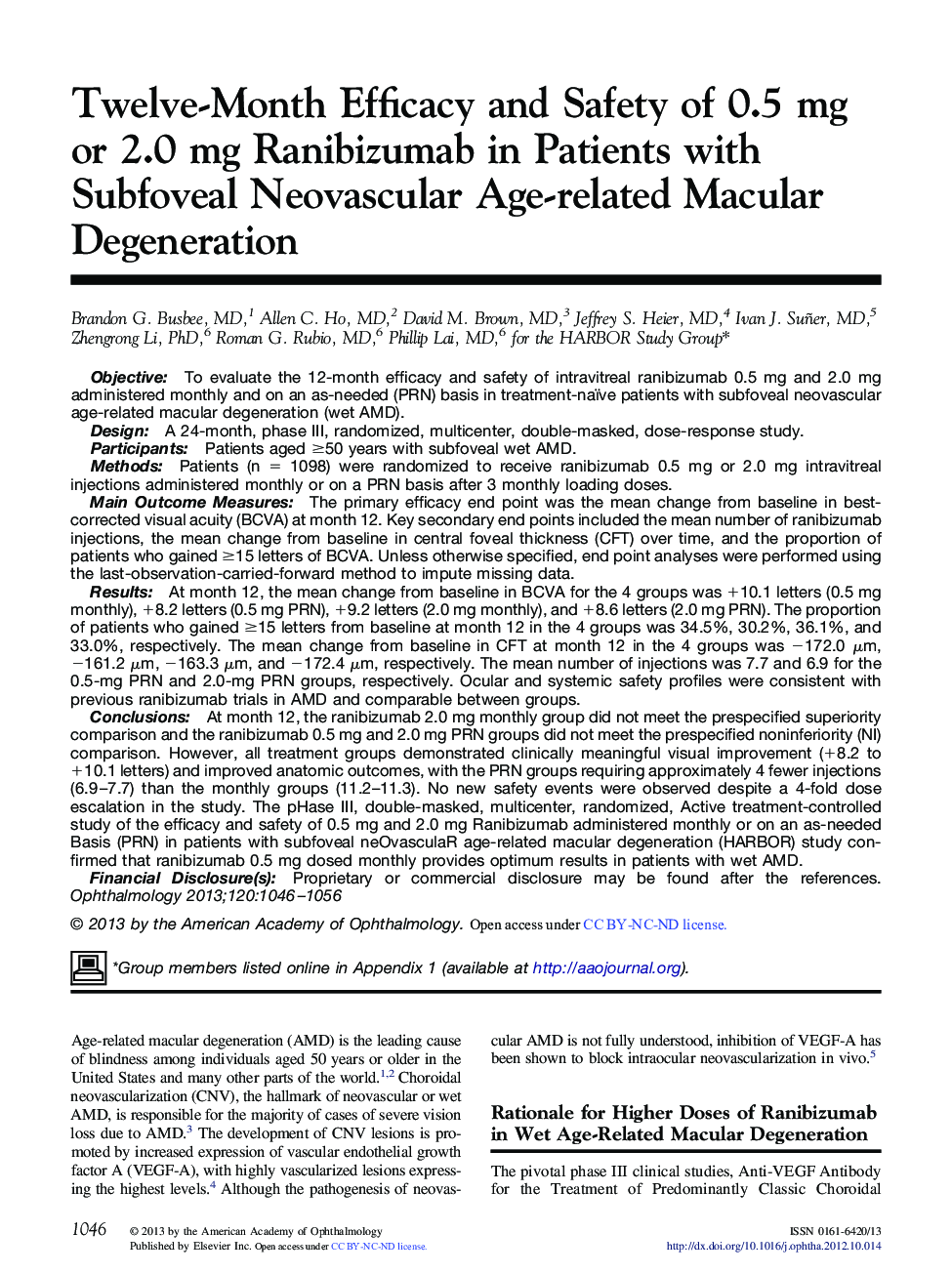| کد مقاله | کد نشریه | سال انتشار | مقاله انگلیسی | نسخه تمام متن |
|---|---|---|---|---|
| 6201964 | 1262436 | 2013 | 11 صفحه PDF | دانلود رایگان |
ObjectiveTo evaluate the 12-month efficacy and safety of intravitreal ranibizumab 0.5 mg and 2.0 mg administered monthly and on an as-needed (PRN) basis in treatment-naïve patients with subfoveal neovascular age-related macular degeneration (wet AMD).DesignA 24-month, phase III, randomized, multicenter, double-masked, dose-response study.ParticipantsPatients aged â¥50 years with subfoveal wet AMD.MethodsPatients (n = 1098) were randomized to receive ranibizumab 0.5 mg or 2.0 mg intravitreal injections administered monthly or on a PRN basis after 3 monthly loading doses.Main Outcome MeasuresThe primary efficacy end point was the mean change from baseline in best-corrected visual acuity (BCVA) at month 12. Key secondary end points included the mean number of ranibizumab injections, the mean change from baseline in central foveal thickness (CFT) over time, and the proportion of patients who gained â¥15 letters of BCVA. Unless otherwise specified, end point analyses were performed using the last-observation-carried-forward method to impute missing data.ResultsAt month 12, the mean change from baseline in BCVA for the 4 groups was +10.1 letters (0.5 mg monthly), +8.2 letters (0.5 mg PRN), +9.2 letters (2.0 mg monthly), and +8.6 letters (2.0 mg PRN). The proportion of patients who gained â¥15 letters from baseline at month 12 in the 4 groups was 34.5%, 30.2%, 36.1%, and 33.0%, respectively. The mean change from baseline in CFT at month 12 in the 4 groups was â172.0 μm, â161.2 μm, â163.3 μm, and â172.4 μm, respectively. The mean number of injections was 7.7 and 6.9 for the 0.5-mg PRN and 2.0-mg PRN groups, respectively. Ocular and systemic safety profiles were consistent with previous ranibizumab trials in AMD and comparable between groups.ConclusionsAt month 12, the ranibizumab 2.0 mg monthly group did not meet the prespecified superiority comparison and the ranibizumab 0.5 mg and 2.0 mg PRN groups did not meet the prespecified noninferiority (NI) comparison. However, all treatment groups demonstrated clinically meaningful visual improvement (+8.2 to +10.1 letters) and improved anatomic outcomes, with the PRN groups requiring approximately 4 fewer injections (6.9-7.7) than the monthly groups (11.2-11.3). No new safety events were observed despite a 4-fold dose escalation in the study. The pHase III, double-masked, multicenter, randomized, Active treatment-controlled study of the efficacy and safety of 0.5 mg and 2.0 mg Ranibizumab administered monthly or on an as-needed Basis (PRN) in patients with subfoveal neOvasculaR age-related macular degeneration (HARBOR) study confirmed that ranibizumab 0.5 mg dosed monthly provides optimum results in patients with wet AMD.Financial Disclosure(s)Proprietary or commercial disclosure may be found after the references.
Journal: Ophthalmology - Volume 120, Issue 5, May 2013, Pages 1046-1056
